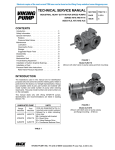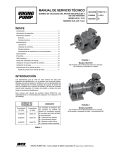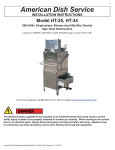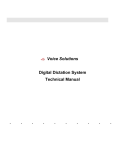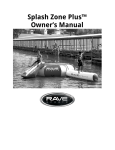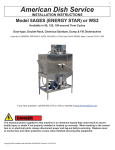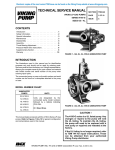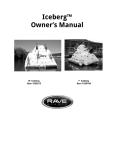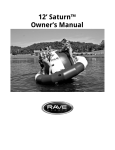Download Viking Pump Technical Service Manual 710.1 for Industrial
Transcript
TECHNICAL SERVICE MANUAL industrial heavy duty motor speed pumps SERIES 4076 AND 4176 SIZES hle, ate and ale CONTENTS Introduction . . . . . . . . . . . . . . . . . . . . . . . . Safety Information . . . . . . . . . . . . . . . . . . . . Special Information . . . . . . . . . . . . . . . . . . . . Rotation . . . . . . . . . . . . . . . . . . . . . . . . Pressure Relief Valves . . . . . . . . . . . . . . . . . Maintenance . . . . . . . . . . . . . . . . . . . . . . . Lubrication . . . . . . . . . . . . . . . . . . . . . . . Cleaning the Pump . . . . . . . . . . . . . . . . . . Storage . . . . . . . . . . . . . . . . . . . . . . . . Suggested Repair Tools . . . . . . . . . . . . . . . . Disassembly . . . . . . . . . . . . . . . . . . . . . . . Assembly . . . . . . . . . . . . . . . . . . . . . . . . . Mechanical Seal . . . . . . . . . . . . . . . . . . . . . Thrust Bearing Adjustment . . . . . . . . . . . . . . . . Installation of Carbon Graphite Bushings . . . . . . . . Installation of Foot . . . . . . . . . . . . . . . . . . . . Pressure Relief Valve Instructions . . . . . . . . . . . . Relief Valve Pressure Adjustment . . . . . . . . . . . 1 2 3 3 3 3 3 3 3 3 4 4 5 5 6 6 6 6 SECTION TSM 710.1 PAGE 1 of 8 ISSUE B figure 1 Model HLE4176 (Shown with relief valve on pump casing and foot mounting) INTRODUCTION The illustrations used in this manual are for identification purposes only and cannot be used for ordering parts. Obtain a parts list from the factory or a Viking® representative. Always give complete name of part, part number and material with model number and serial number of pump when ordering repair parts. The pump model number and serial number are on the nameplate. This manual deals only with Viking 4076/4176 pumps. Specifications and recommendations are listed in Catalog Section 710. UNITS figure 2 Units are designated by the unmounted pump model numbers followed by a letter indicating drive style. M = Horizontal with bracket D = Direct Drive R = Viking Reducer Drive P = Commercial Reducer Drive Model ALE 4076 (Shown with relief valve on pump casing and flange mounting – M Drive) UNMOUNTED PUMP Flange Mounted Foot Mounted HLE4076 HLE4176 ATE4076 ATE4176 ALE4076 ALE4176 table 1 VIKING PUMP, INC. • A Unit of IDEX Corporation • Cedar Falls, IA 50613 USA SAFETY INFORMATION AND INSTRUCTIONS IMPROPER INSTALLATION, OPERATION OR MAINTENANCE OF PUMP MAY CAUSE SERIOUS INJURY OR DEATH AND/OR RESULT IN DAMAGE TO PUMP AND/OR OTHER EQUIPMENT. VIKING’S WARRANTY DOES NOT COVER FAILURE DUE TO IMPROPER INSTALLATION, OPERATION OR MAINTENANCE. THIS INFORMATION MUST BE FULLY READ BEFORE BEGINNING INSTALLATION, OPERATION OR MAINTENANCE OF PUMP AND MUST BE KEPT WITH PUMP. PUMP MUST BE INSTALLED, OPERATED AND MAINTAINED ONLY BY SUITABLY TRAINED AND QUALIFIED PERSONS. THE FOLLOWING SAFETY INSTRUCTIONS MUST BE FOLLOWED AND ADHERED TO AT ALL TIMES. Symbol Legend : ! ! Danger - Failure to follow the indicated instruction may result in serious injury or death. BEFORE opening any liquid chamber (pumping chamber, reservoir, relief valve adjusting cap fitting, etc.) be sure that : ● Any pressure in the chamber has been completely vented through the suction or discharge lines or other appropriate openings or connections. ● The pump drive system means (motor, turbine, engine, etc.) has been “locked out” or otherwise been made non-operational so that it cannot be started while work is being done on the pump. WARNING WARNING ! WARNING ● You know what material the pump has been handling, have obtained a material safety data sheet (MSDS) for the material, and understand and follow all precautions appropriate for the safe handling of the material. ! ! ! ! WARNING ! WARNING BEFORE operating the pump, be sure all drive guards are in place. DO NOT operate pump if the suction or discharge piping is not connected. ! ! DO NOT place fingers into the pumping chamber or its connection ports or into any part of the drive train if there is any possibility of the pump shafts being rotated. DO NOT exceed the pumps rated pressure, speed, and temperature, or change the system/duty parameters from those the pump was originally supplied, without confirming its suitability for the new service. ! WARNING BEFORE operating the pump, be sure that: ● It is clean and free from debris ● all valves in the suction and discharge pipelines are fully opened. ● All piping connected to the pump is fully supported and correctly aligned with the pump. ● Pump rotation is correct for the desired direction of flow. ! WARNING SECTION TSM 710.1 ISSUE B PAGE OF 8 Warning - In addition to possible serious injury or death, failure to follow the indicated instruction may cause damage to pump and/or other equipment. INSTALL pressure gauges/sensors next to the pump suction and discharge connections to monitor pressures. USE extreme caution when lifting the pump. Suitable lifting devices should be used when appropriate. Lifting eyes installed on the pump must be used only to lift the pump, not the pump with drive and/or base plate. If the pump is mounted on a base plate, the base plate must be used for all lifting purposes. If slings are used for lifting, they must be safely and securely attached. For weight of the pump alone (which does not include the drive and/or base plate) refer to the Viking Pump product catalog. DO NOT attempt to dismantle a pressure relief valve that has not had the spring pressure relieved or is mounted on a pump that is operating. AVOID contact with hot areas of the pump and/or drive. Certain operating conditions, temperature control devices (jackets, heat-tracing, etc.), improper installation, improper operation, and improper maintenance can all cause high temperatures on the pump and/or drive. THE PUMP must be provided with pressure protection. This may be provided through a relief valve mounted directly on the pump, an in-line pressure relief valve, a torque limiting device, or a rupture disk. If pump rotation may be reversed during operation, pressure protection must be provided on both sides of pump. Relief valve adjusting screw caps must always point towards suction side of the pump. If pump rotation is reversed, position of the relief valve must be changed. Pressure relief valves cannot be used to control pump flow or regulate discharge pressure. For additional information, refer to Viking Pump’s Technical Service Manual TSM 000 and Engineering Service Bulletin ESB-31. THE PUMP must be installed in a matter that allows safe access for routine maintenance and for inspection during operation to check for leakage and monitor pump operation. SPECIAL INFORMATION DANGER ! Before opening any Viking pump liquid chamber (pumping chamber, reservoir, relief valve adjusting cap fitting, etc.) be sure: 1. That any pressure in the chamber has been completely vented through the suction or discharge lines or other appropriate openings or connections. 2. That the driving means (motor, turbine, engine, etc.) has been “locked out” or made non-operational so that it cannot be started while work is being done on the pump. 3. That you know what liquid the pump has been handling and the precautions necessary to safely handle the liquid. Obtain a material safety data sheet (MSDS) for the liquid to be sure these precautions are understood. Failure to follow the above listed precautionary measures may result in serious injury or death. PRESSURE RELIEF VALVES: Viking pumps are positive displacement pumps and must be provided with some form of pressure protection. This may be a relief valve mounted directly on the pump, an in-line pressure relief valve, a torque limiting device or a rupture disk. Pumps equipped with relief valves have them mounted on the casing. If pump rotation is reversed during operation, pressure protection must be provided on both the sides of the pump. The relief valve adjusting screw cap must always point towards the pump suction port. Pressure relief valves are intended for use as a protection for the pump only and should not be used to control pump flow or regulate discharge pressure. MAINTENANCE Viking 4076/4176 pumps are designed for long, trouble-free service life under a variety of application conditions with a minimum of maintenance. The following points will help provide long service life. LUBRICATION: External lubrication must be applied slowly with a hand gun to the lubrication fitting every 500 hours of operation with multipurpose grease, NLGI #2. Do not over-grease. Applications involving very high or low temperatures will require other types of lubrication. Refer to Engineering Service Bulletin ESB-515. Consult factory with specific lubrication questions. Note that the bushings used in this pump do not require any external lubrication. ROTATION: See Figure 3. Viking 4076/4176 pumps are directional due to the loading groove in the head. Standard rotation is clockwise as viewed from the shaft end. If rotation is to be reversed, the following items need to be changed: 1. The head and pin assembly must be replaced. 2. Position of the relief valve will have to be changed. Install so the adjusting screw cap points towards the suction side of the pump. 3. The flush line must be switched to the opposite port. loading groove CLEANING THE PUMP: Keep the pump as clean as possible. This will facilitate inspection, adjustment and repair work and help prevent overlooking a dirt covered grease fitting. STORAGE: If the pump is to be stored, or not used for six months or more, pump must be drained and a light coat of non-detergent SAE 30 weight oil must be applied to all internal pump parts. Lubricate the fittings and apply grease to the pump shaft extension. Viking suggests rotating the pump shaft by hand one complete revolution every 30 days to circulate the oil. SUGGESTED REPAIR TOOLS: The following tools must be available to properly repair Viking series 4076/4176 pumps. These tools are in addition to standard mechanics’ tools such as open end wrenches, pliers and screw drivers. Most items can be obtained from an industrial supply house. 1. 2. 3. 4. Soft headed hammer Allen wrenches Bearing locknut spanner wrench Spanner wrench, adjustable pin type for use on bearing housing end cap 5. Brass bar or wood block 6. Arbor press figure 3 (Counter Clockwise Rotation Shown) SECTION TSM 710.1 ISSUE B PAGE OF 8 DISASSEMBLY DANGER ! Before opening any Viking pump liquid chamber (pumping chamber, reservoir, relief valve adjusting cap fitting, etc.) Be sure: 1. That any pressure in the chamber has been completely vented through the suction or discharge lines or other appropriate openings or connections. figure 4 2. That the driving means (motor, turbine, engine, etc.) has been “locked out” or made non-operational so that it cannot be started while work is being done on pump. 3. That you know what liquid the pump has been handling and the precautions necessary to safely handle the liquid. Obtain a material safety data sheet (MSDS) for the liquid to be sure these precautions are understood. Failure to follow above listed precautionary measures may result in serious injury or death. 1. Remove the head capscrews. Remove the head of the pump. Do not allow the idler to fall from the idler pin. To prevent this from happening, tilt the top of the head back when removing. Avoid damaging the head o-ring. f the pump is furnished with a jacketed head plate, it will separate from the head when the capscrews are removed. Avoid damaging the jacketed head plate o-ring. 2. Remove the idler and bushing assembly. 3. Insert a length of hardwood or brass through either port opening between the rotor teeth to keep the shaft from turning. Remove the lock nut using a standard open end wrench. 4. Loosen the two setscrews in the face of the bearing housing and unthread the bearing housing assembly from the bracket. The end of the bearing housing contains the mechanical seal seat. Avoid damaging this surface. See FIGURE 4. 5. Remove the rotor and shaft assembly being careful to avoid damaging the mechanical seal face and casing bushing. 6. Remove the rotating member of the mechanical seal from the shaft only if the seal is to be replaced. ASSEMBLY 1. Install the casing bushing. See “INSTALLATION OF CARBON GRAPHITE BUSHINGS” on page 6. 2. Apply a light coating of oil onto the shaft in the seal area. install the rotating member of the mechanical seal onto the rotor and shaft assembly. Slide the seal all the way to the shoulder on the shaft. 3. Slide the rotor and shaft assembly into the casing, taking care not to damage the bushing or the mechanical seal face. NOTE: When installing a new rotor and shaft assembly, use a file to carefully remove all burrs and sharp edges. 4. Coat the head o-ring with oil or grease and slip it over the head pilot to keep it in place. Apply a coating of light oil onto the bushing inside diameter and the crescent. Place the idler and bushing assembly onto the idler pin. NOTE: When installing a new head and pin assembly, use a file to carefully remove all burrs and sharp edges, especially around the loading groove. 5. Install the head. For proper head positioning, the pin should be at the top centered between the two ports. If the pump is equipped with a jacketed head plate, make sure the o-ring is in place and install at this time. Tighten the capscrews evenly. Refer to FIGURE 4 for bearing housing assembly. NOTE: To facilitate assembly, place the pump casing so that it is standing on one of its flanges with a block of wood under the mounting flange. See FIGURE 5. SECTION TSM 710.1 figure 5 ISSUE B PAGE OF 8 6. Install the lip seal in the bearing housing. See FIGURE 4 for lip orientation. 7. Pack the ball bearing with grease and push or press the bearing into the bearing housing. 13 2 1 4 3 2 5 6 4 14 16 16 24 8 7 24 9 11 12 23 15 23 21 21 HLE RELIEF VALVE ONLY 10 22 17 18 19 20 25 26 27 28 29 30 31 32 33 34 figure 6 eXPLODED vIEW OF vIKING sERIES 4076 / 4176 pUMPS ITEM NAME OF PART ITEM NAME OF PART 1 Locknut Bearing Spacer Collar (2-Req’d) End Cap Lip Seal (2-Req’d) Ball Bearing Setscrew (2-Req’d) Bearing Housing Setscrew (2-Req’d) Nylon Insert (2-Req’d) O-Ring For Seal Seat Mechanical Seal Grease Fitting 13 Flush Line Assembly Pipe Plug Casing and Bushing Assembly Relief Valve Assembly Dowel Pin (2-Req’d - 4176 Series Only) Foot (4176 Series Only) Lockwashers for Foot (4176 Series Only) Capscrews for Foot (4176 Series Only) Relief Valve Gasket (2-Req’d on ATE & ALE) Casing Bushing Cover Plate (Pumps Less Valve 2-Req’d on ATE & ALE) Capscrews for Relief Valve or Cover Plate 2 3 4 5 6 7 8 9 10 11 12 14 15 16 17 18 19 20 21 22 23 24 ITEM NAME OF PART Rotor and Shaft Assembly 26 Idler and Bushing Assembly 27 Idler Bushing 28 O-Ring For Head 29 Idler Pin 30 Head and Lube Idler Pin Assembly 31 Pipe Plug, Hex Head, 1/8” BSP (ALE & ATE) 32 O-Ring For Jacketed Head Plate (Optional) 33 Jacketed Head Plate (Optional) 34 Head Capscrews Not Illus. Pipe Flange Gasket (2-Req’d) 25 table 2 8. Install the lip seal in the end cap. See FIGURE 4 for lip orientation. Thread the end cap into the bearing housing along with the outer bearing spacer collar. Tighten the end cap. Lock the end cap in place with two radial setscrews in the flange of the bearing housing. 11. Insert a length of hardwood or brass through either port opening between the rotor teeth. This will keep the shaft from turning when the lock nut is tightened. Install the lock nut and tighten to 70-95 N•m on HLE pumps and 135-175 N•m on ATE and ALE pumps. 9. See FIGURE 7 and notes under “MECHANICAL SEAL” on this page. Lubricate the outside diameter of the seat gasket and install the stationary member of the mechanical seal into the end of the bearing housing. Note the shinny side of the seal seat faces out. 12. Adjust the pump end clearance as described in “THRUST BEARING ADJUSTMENT” on page 6. 13. Lubricate the grease fitting with multi-purpose grease, NLGI #2. 10. Slide the inner bearing spacer collar onto the shaft. Thread the bearing housing assembly into the bracket. SECTION TSM 710.1 ISSUE B PAGE OF 8 DANGER ! Before starting the pump, be sure all drive equipment guards are in place. Failure to properly mount guards may result in serious injury or death. MECHANICAL SEAL For disassembly, see “DISASSEMBLY” on page 4. For assembly, see “ASSEMBLY” on page 4. NOTE: Never touch the mechanical seal faces with anything except clean hands or a clean cloth. Minute particles can scratch the seal faces and cause leakage. Always clean the rotor and shaft and seal housing bore before installing the mechanical seal. Make sure surfaces are clean and free of scratches. There are two available mechanical seals. The standard features a cup type seat. A “pin style” seal is also available that has the seal seat pinned to prevent rotation. This design is used for viscosities higher than 750 cPs. NOTE: Be sure the shaft rotates freely. If it doesn’t, repeat the above procedure. 4. High viscosity liquids require additional end clearances. The amount of extra clearance depends on the viscosity of the liquid pumped. For specific recommendations, consult the factory. Table 3 shows the bearing housing adjustment required for additional end clearance as well as values for standard end clearance. PUMP SIZE STANDARD END CLEARANCE (mm) HLE LENGTH ON OD* (mm) FOR STD. EACH .025 mm ADDITIONAL .08 12 4 ATE .08 15 5 ALE .08 15 5 * Turn bearing housing CCW this distance to obtain either standard or additional end clearance. TABLE 3 INSTALLATION OF CARBON GRAPHITE BUSHINGS When installing Carbon graphite bushings, extreme care must be taken to prevent breaking. Carbon graphite is a brittle material and cracks easily. If cracked, the bushing will quickly disintegrate. Using a lubricant on the bushing and the mating part will help in installation. The additional precautions listed below must be followed for proper installation: 1. A press must be used for installation. 2. Be certain the bushing is straight. 3. Do not stop the pressing operation until the bushing is in the proper position, starting and stopping will result in a cracked bushing. 4. Check the bushing for cracks after installation. FIGURE 7 THRUST BEARING ADJUSTMENT See FIGURE 4 on page 3. 1. Loosen the two setscrews in the outer face of the bearing housing and turn the thrust bearing assembly clockwise until it can no longer be turned by hand. Back off counterclockwise until the rotor shaft can be turned by hand with a slight, noticeable drag. 2. For standard end clearance, back off the thrust bearing assembly the required length as measured on the outside diameter of the bearing housing (See Table 3). 3. Tighten the two self locking type “Allen” setscrews in the outboard face of the bearing housing. Tighten each with equal force against the bracket. The pump is now set with standard end clearance. SECTION TSM 710.1 ISSUE B PAGE OF 8 INSTALLATION OF FOOT Series 4176 pumps come equipped with a removable foot. Removal of the foot is not normally required for maintenance. In cases where the foot needs to be replaced or is being added, use the following steps. 1. Ensure alignment pins are installed in the top of the foot prior to assembly of the foot to the casing. 2. Match the foot to the casing by inserting pins into the bottom of the casing. 3. Secure foot to casing using the socket head capscrews and lock washers. Torque capscrews to 100-110 N•m. PRESSURE RELIEF VALVE INSTRUCTIONS 2 1 3 4 5 6 8 7 DANGER ! Before opening any Viking pump liquid chamber (pumping chamber, reservoir, relief valve adjusting cap fitting, etc.) Be sure: 1. That any pressure in the chamber has been completely vented through the suction or discharge lines or other appropriate openings or connections. A 9 2. That the driving means (motor, turbine, engine, etc.) has been “locked out” or made non-operational so that it cannot be started while work is being done on pump. FIGURE 8 SIZE HLE VALVE - LIST OF PARTS 3. That you know what liquid the pump has been handling and the precautions necessary to safely handle the liquid. Obtain a material safety data sheet (MSDS) for the liquid to be sure these precautions are understood. 1. Valve Cap 6. Valve Body 2. Adjusting Screw 7. Valve Spring 3. Lock Nut 8. Poppet 4. Bonnet 9. Cap Gasket 5. Spring Guide Failure to follow above listed precautionary measures may result in serious injury or death. 1 2 3 4 5 6 7 8 RELIEF VALVE PRESSURE ADJUSTMENT: If a new spring is installed or if the pressure setting of the pressure relief valve is changed from what the factory has set, the following instructions must be carefully followed. 1. Carefully remove the valve cap that covers the adjusting screw. Note this cap will most likely contain liquid. 2. Loosen the locknut that keeps the adjusting screw from turning while the pump is in operation. 3. Install a pressure gauge in the discharge line. This will be required for the pressure adjustment operation. 4. Turn the adjusting screw in to increase the pressure and out to decrease the pressure. A 9 10 5. With the discharge line closed at a point beyond the pressure gauge, the gauge will show the maximum pressure that the valve will allow while the pump is in operation IMPORTANT When ordering parts for a pressure relief valve, always give the model number and serial number of the pump as it appears on the nameplate. Also specify the name of the part(s) wanted. When ordering springs, be sure to give the pressure settings desired. FIGURE 9 SIZES ATE & ALE VALVE - LIST OF PARTS 1. Valve Cap 6. Valve Body 2. Adjusting Screw 7. Valve Spring 3. Lock Nut 8. Poppet 4. Spring Guide 9. Cap Gasket 5. Bonnet 10 SECTION TSM 710.1 Bonnet Gasket ISSUE B PAGE OF 8 TECHNICAL SERVICE MANUAL industrial heavy duty motor speed pumps SERIES 4076 AND 4176 SIZES hle, ate and ale SECTION TSM 710.1 PAGE of 8 ISSUE B WARRANTY Viking warrants all products manufactured by it to be free from defects in workmanship or material for a period of one (1) year from date of startup, provided that in no event shall this warranty extend more than eighteen (18) months from the date of shipment from Viking. If, during said warranty period, any products sold by Viking prove to be defective in workmanship or material under normal use and service, and if such products are returned to Viking’s factory at Cedar Falls, Iowa, transportation charges prepaid, and if the products are found by Viking to be defective in workmanship or material, they will be replaced or repaired free of charge, FOB. Cedar Falls, Iowa. Viking assumes no liability for consequential damages of any kind and the purchaser by acceptance of delivery assumes all liability for the consequences of the use or misuse of Viking products by the purchaser, his employees or others. Viking will assume no field expense for service or parts unless authorized by it in advance. Equipment and accessories purchased by Viking from outside sources which are incorporated into any Viking product are warranted only to the extent of and by the original manufacturer’s warranty or guarantee, if any. THIS IS VIKING’S SOLE WARRANTY AND IS IN LIEU OF ALL OTHER WARRANTIES, EXPRESSED OR IMPLIED, WHICH ARE HEREBY EXCLUDED, INCLUDING IN PARTICULAR ALL WARRANTIES OF MERCHANTABILITY OR FITNESS FOR A PARTICULAR PURPOSE. No officer or employee of IDEX Corporation or Viking Pump, Inc. is authorized to alter this warranty. VIKING PUMP, INC. • A Unit of IDEX Corporation • Cedar Falls, IA 50613 USA © 5/2007 Viking Pump Inc. All rights reserved








